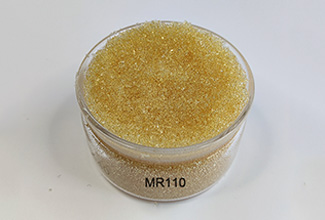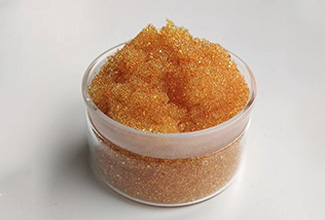Physical properties of ion exchange resins
1. The particle size and related physical properties of an ion exchange resin have a significant impact on its operation and performance.
(1) Resin particle size
The size of the ion exchange resin, which is usually made into small, bead-like particles, is also important. The finer the resin particles, the greater the reaction rate, but the finer particles have a greater resistance to the passage of the liquid and require a higher working pressure; this effect is particularly significant with the high viscosity of concentrated sugar liquids. Therefore, the size of the resin particles should be selected appropriately. If the resin particle size is below 0.2mm (approximately 70 mesh), it will significantly increase the resistance to fluid passage and reduce the flow rate and production capacity.
The size of the resin particles is usually determined by the wet sieve method, where the resin is sieved after it has swollen sufficiently to absorb water, and its retention on a 20, 30, 40, 50 ...... mesh sieve is accumulated to the extent that 90% of the particles can pass through its corresponding sieve diameter, called the "effective particle size" of the resin. ". Most common resin products have an effective particle size between 0.4 and 0.6mm.
The uniformity of the resin particles is expressed as a uniformity factor. It is the ratio of the corresponding sieve diameter to the effective particle size, taking the cumulative retention of 40% of the particles on the "effective particle size" coordinate chart of the measured resin. If a resin (IR-120) has an effective particle size of 0.4 to 0.6mm, it retains 18.3%, 41.1% and 31.3% of particles on a 20-mesh sieve, a 30-mesh sieve and a 40-mesh sieve respectively, the uniformity factor is calculated to be 2.0.
(2) Density of the resin
The density of a resin when dried is called the true density. The weight of the wet resin per unit volume (including the space between the particles) is called the apparent density. The density of a resin is related to its degree of cross-linking and the nature of the exchange groups. Usually, the density of resin with high cross-linkage is higher, the density of strongly acidic or strongly basic resin is higher than that of weakly acidic or weakly basic one, while the density of macroporous resin is lower. For example, the true density of styrene gel type strong acid cation resin is 1.26g/mL and the apparent density is 0.85g/mL, while the true density of acrylic gel type weak acid cation resin is 1.19g/mL and the apparent density is 0.75g/mL.
(3) Solubility of the resin
Ion exchange resins are insoluble substances. However, substances with a low degree of polymerisation that are entrapped in the resin during the synthesis process, as well as substances generated by the decomposition of the resin, will dissolve out during operation. Resins with a low degree of cross-linking and a large number of reactive groups have a greater tendency to dissolve.
(4) Swelling
Ion exchange resins contain a large number of hydrophilic groups and swell when in contact with water. When the ions in the resin change, e.g. from H+ to Na+ for cationic resins and from Cl- to OH- for anionic resins, swelling occurs due to the increase in ion diameter, increasing the volume of the resin. As a rule, resins with low cross-linkage have a greater swelling. When designing an ion exchange unit, the swelling of the resin must be taken into account to accommodate the change in resin volume that occurs as a result of ion conversion in the resin during production operation.
(5) Durability
Resin particles are subject to changes such as transfer, friction, expansion and shrinkage during use, and a small amount of loss and breakage after long-term use, so the resin should have high mechanical strength and wear resistance. Generally, resins with low cross-linking are more likely to break, but the durability of the resin is determined more by the uniformity of the cross-linked structure and its strength. Resins with a high degree of crosslinking, such as macroporous resins, have a stable structure and can withstand repeated regeneration.
(1) Resin particle size
The size of the ion exchange resin, which is usually made into small, bead-like particles, is also important. The finer the resin particles, the greater the reaction rate, but the finer particles have a greater resistance to the passage of the liquid and require a higher working pressure; this effect is particularly significant with the high viscosity of concentrated sugar liquids. Therefore, the size of the resin particles should be selected appropriately. If the resin particle size is below 0.2mm (approximately 70 mesh), it will significantly increase the resistance to fluid passage and reduce the flow rate and production capacity.
The size of the resin particles is usually determined by the wet sieve method, where the resin is sieved after it has swollen sufficiently to absorb water, and its retention on a 20, 30, 40, 50 ...... mesh sieve is accumulated to the extent that 90% of the particles can pass through its corresponding sieve diameter, called the "effective particle size" of the resin. ". Most common resin products have an effective particle size between 0.4 and 0.6mm.
The uniformity of the resin particles is expressed as a uniformity factor. It is the ratio of the corresponding sieve diameter to the effective particle size, taking the cumulative retention of 40% of the particles on the "effective particle size" coordinate chart of the measured resin. If a resin (IR-120) has an effective particle size of 0.4 to 0.6mm, it retains 18.3%, 41.1% and 31.3% of particles on a 20-mesh sieve, a 30-mesh sieve and a 40-mesh sieve respectively, the uniformity factor is calculated to be 2.0.
(2) Density of the resin
The density of a resin when dried is called the true density. The weight of the wet resin per unit volume (including the space between the particles) is called the apparent density. The density of a resin is related to its degree of cross-linking and the nature of the exchange groups. Usually, the density of resin with high cross-linkage is higher, the density of strongly acidic or strongly basic resin is higher than that of weakly acidic or weakly basic one, while the density of macroporous resin is lower. For example, the true density of styrene gel type strong acid cation resin is 1.26g/mL and the apparent density is 0.85g/mL, while the true density of acrylic gel type weak acid cation resin is 1.19g/mL and the apparent density is 0.75g/mL.
(3) Solubility of the resin
Ion exchange resins are insoluble substances. However, substances with a low degree of polymerisation that are entrapped in the resin during the synthesis process, as well as substances generated by the decomposition of the resin, will dissolve out during operation. Resins with a low degree of cross-linking and a large number of reactive groups have a greater tendency to dissolve.
(4) Swelling
Ion exchange resins contain a large number of hydrophilic groups and swell when in contact with water. When the ions in the resin change, e.g. from H+ to Na+ for cationic resins and from Cl- to OH- for anionic resins, swelling occurs due to the increase in ion diameter, increasing the volume of the resin. As a rule, resins with low cross-linkage have a greater swelling. When designing an ion exchange unit, the swelling of the resin must be taken into account to accommodate the change in resin volume that occurs as a result of ion conversion in the resin during production operation.
(5) Durability
Resin particles are subject to changes such as transfer, friction, expansion and shrinkage during use, and a small amount of loss and breakage after long-term use, so the resin should have high mechanical strength and wear resistance. Generally, resins with low cross-linking are more likely to break, but the durability of the resin is determined more by the uniformity of the cross-linked structure and its strength. Resins with a high degree of crosslinking, such as macroporous resins, have a stable structure and can withstand repeated regeneration.
Related Products
-
 001X7 Cation Exchange ResinIonic form:Na+Appearance: Claybank to tan transparent spherical particle.The degree of crosslinking : 7%.
001X7 Cation Exchange ResinIonic form:Na+Appearance: Claybank to tan transparent spherical particle.The degree of crosslinking : 7%. -
 MR110 Mixed Bed Ion Exchange ResinAppearance: Yellow-brown spherical particles.Ionic form:H+/OH-Volume complete exchange capacity(mmol/ml):≥0.6
MR110 Mixed Bed Ion Exchange ResinAppearance: Yellow-brown spherical particles.Ionic form:H+/OH-Volume complete exchange capacity(mmol/ml):≥0.6 -
 C010FG Food Grade Drug Purification Exchange ResinAppearance: Claybank to tan transparent spherical particle.The degree of crosslinking : 10%.Ionic form:Na+
C010FG Food Grade Drug Purification Exchange ResinAppearance: Claybank to tan transparent spherical particle.The degree of crosslinking : 10%.Ionic form:Na+
Message

